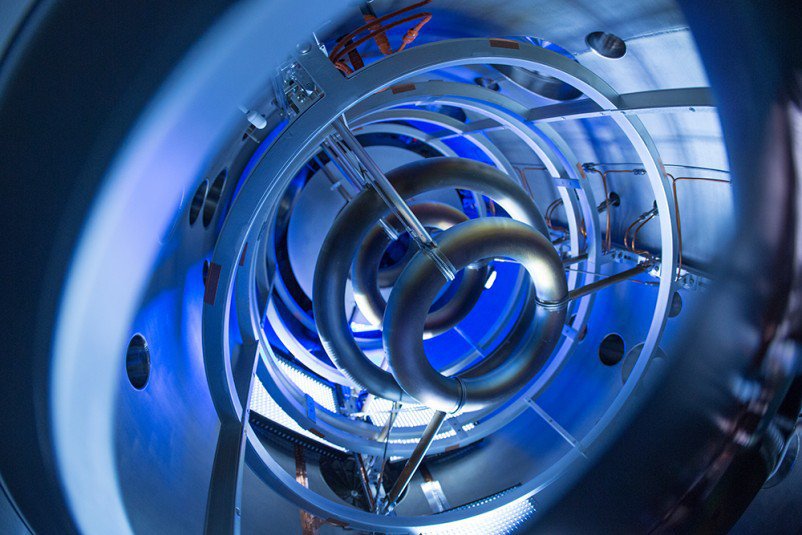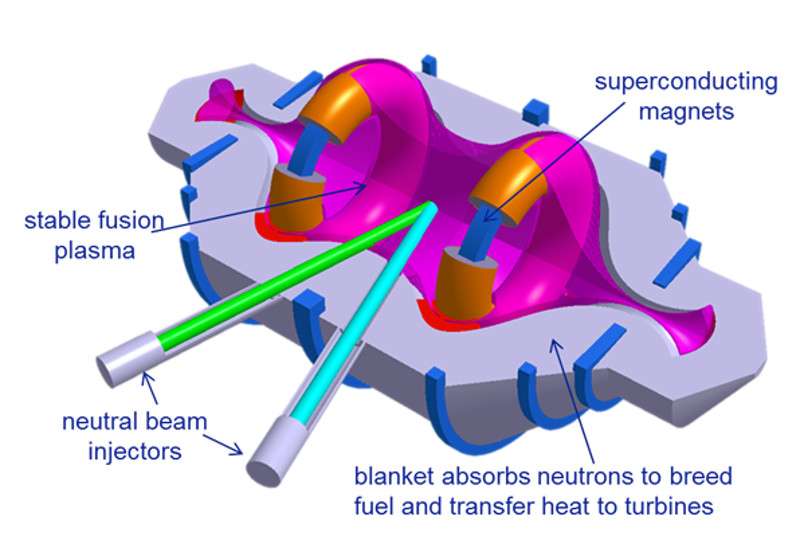
The company Lockheed Martin quietly received a patent for a device that does not exceed the size of a regular container, but allows us to provide about 80 thousand houses with energy. The patent deals with the "magnetic plasma concentrator", but this, as far as can be understood, is in fact a portable thermonuclear reactor. So far there is only a patent, with drawings and descriptions, and the company has not submitted a working installation. Nevertheless, there is a far from zero chance that all this will turn out to be a reality and Lockheed Martin will show his invention in the near future.
The patent is dated February 15, 2018. The whole story began in 2013, and in 2014, representatives of Lockheed Martin let them know that they were working on a device of this kind. Then a scientist named Thomas McGuire, head of the
Compact Fusion Project , announced his intention to complete the development within five years. In 2013, he announced his intention to get a working prototype in five years, and in ten years - to start industrial production of such systems. Project Skunk Works is a division of Lockheed Martin.
According to McGuire, he read everything he could that had to do with a thermonuclear reactor. As a result, he had an idea in his head, how to combine all the read ideas, transform it into something qualitatively new. In principle, McGuire has the necessary qualifications to work in the field of fusion energy. McGuire did a Ph.D. thesis at the Massachusetts Institute of Technology. He studied thermonuclear fusion in graduate school, as a possible source of motion in space, in connection with NASA plans to reduce the time to travel to Mars. In the early 2000s, he decided to create a hybrid device, which is devoid of problems typical of most prototype fusion reactor systems. All of the above may seem like a joke, but the representatives of Lockheed Martin really talked about a fusion reactor back in 2014.
Information about thermonuclear energy and installations that are capable of producing it is a huge amount. Since the 20s of the last century, scientists have been trying to imagine how a fusion device, a reactor should look and function, creating conceptual prototypes of devices. They are all huge and very expensive. For example, the
International Thermonuclear Experimental Reactor , which the international community is working on in France, costs about $ 50 billion and weighs about 23,000 tons. The reactor should be ready somewhere by 2021.
The most interesting thing is that Guaira works with the tokamak concept. Modified, but still a concept.
Tokamak (toroidal chamber with magnetic coils) is a toroidal installation for magnetic plasma confinement in order to achieve the conditions necessary for the flow of controlled thermonuclear fusion. The corresponding system design was first proposed in the Soviet Union back in the 1950s, after which Soviet scientists began to work actively on the creation of a thermonuclear facility. Then it seemed that only a few years remained before the creation of a working fusion reactor. Well, maybe 10-20 years. But no, it took much more time to create at least a more or less working prototype of a system capable of generating and maintaining a plasma for any meaningful time (of a fraction of a second). Tokamaks have a technical limitation on plasma confinement due to the relatively low “magnetic pressure”.
Tokamaks can cope only with a certain amount of plasma, which has received its own name - beta limit. A portable installation from Lockheed Martin holds a magnetic plasma with a magnetic mirror. The magnetic fields of high density at the same time reflect moving particles inside, where there is a sufficiently low density of magnetic fields. The company is focused on creating a relatively small device, the size of which is comparable to a conventional jet engine. According to representatives of the corporation, its idea allows faster to achieve the emergence and spread of fusion reactors than in the case of such large-scale projects as Joint European Torus or ITER.
For the operation of the magnetic mirror, two sets of "mirrors" are used. The first is located inside the cylindrical vessel of the reactor at both its ends. Another set surrounds the reactor cylinder. Ring magnets produce a “diamagnetic peak”, a particular form of magnetic field. Inside it, the magnetic forces quickly change direction, compressing the nucleus to the midpoint between the two rings. The fields of the external magnets press the nucleus back to the ends of the vessel. This process is known as “recycling”.
One of the new elements in the construction of such devices is superconducting magnets, which allow you to create strong magnetic fields with less energy than ordinary magnets. Moreover, the project does not provide for a net current, which, according to Lockheed, removes the main source of plasma instability and improves confinement. A small amount of plasma at the same time reduces the energy that is needed to achieve synthesis. As part of the project, it is planned to replace microwave emitters that heat the plasma to conventional neutral particle beam injectors, where electrically neutral deuterium atoms transfer their energy to the plasma. In such installations, the calculated plasma pressure to the magnetic field pressure is approximately an order of magnitude higher than in tokamaks.
Naturally, such an installation, if it turns out to be efficient, will not only completely change the energy infrastructure of a civilization, but also change humanity itself, which will receive an almost inexhaustible source of energy. Approximately 11 kg of fuel (deuterium and tritium) will be enough for the installation to operate for a whole year without stopping. The device will be able to generate about 100 MW per year.
The reactor will be powerful enough to supply energy to an entire aircraft carrier or a city with a population of 50-100 thousand people. Perhaps it is precisely such an installation that will finally make the road to Mars possible, and it will shorten the travel time due to the opportunity to speed up the rocket. On the basis of such reactors it will be possible to come up with anything. They will be able to supply humanity with energy on the Moon or Mars, to give unlimited amounts of electricity on Earth.
Aircraft will be limited only by the amount of water, food and other components that are necessary to maintain the life of the team. Fuel enough for many years of work. If we talk about unmanned vehicles, then they will be able to fly at all for years, not to mention satellites and other systems. Such UAVs can monitor large areas of land and sea, making it difficult for intruders to enter the coastal waters of any states.
 Structure of a portable fusion reactor company Lockheed Martin. It is unclear whether there is a working prototype or just pictures.
Structure of a portable fusion reactor company Lockheed Martin. It is unclear whether there is a working prototype or just pictures.You can imagine trucks that are equipped with such an installation. They will not need fuel and they will be able to drive on the roads for years, especially if they are unmanned trucks, which are created by representatives of the automotive industry.
And it will be almost pure energy, which will not have a negative impact on the environment. Thermonuclear reactors do not produce radiation or harmful compounds. On the basis of thermonuclear reactors, it will be possible to provide energy to schools, hospitals, and government institutions. Deuterium and tritium, fuel for reactors of this type, can be obtained without problems. Coal, gas, oil - all this will be a thing of the past. Somewhere, fossil fuels will be used, but thermonades will come to replace all of this. A small rector will allow to restore energy supply in the city of any country cut off from the world due to a catastrophe (earthquake, flood, war, etc.).
Of course, it remains the case for small - to understand when the company will launch its reactors, if at all. The problem is that Lockheed Martin is not the first or even the second company that is trying to create a working fusion device. Previously, all such attempts ended in nothing, although many projects were discussed, and very actively. Maybe this is just a “hypothetical” patent, which provides for the possibility of creating a certain technology. The suspicion that the company does not have a ready-made development is caused by the fact that the US government has the right to close patents for public familiarization if they pose a threat to national security, but the “portable thermonuclear fusion” is in the public domain. There are a lot of possible problems with the patent and the technology itself, so it seems strange that the United States didn’t do anything to close the patent, if there is still development.
On the other hand, Skunk Works can really have something “for the soul”, and that is why the unit is trying to gradually make itself felt, so that the presentation of the technology, if it is, goes with pomp. Representatives of the company gave comments of various kinds of media, saying that the technology is gradually evolving. Maybe this is true, since the company itself is very reputable, the representatives of Lockheed Martin do not give up.
Well, given that McGuire in 2014 was talking about a five-year development period, the likelihood that something new will soon be shown is non-zero. Hopefully, the company has really invented something that can change our future for the better. It remains only to wait for a denial or confirmation of rumors and suspicions.